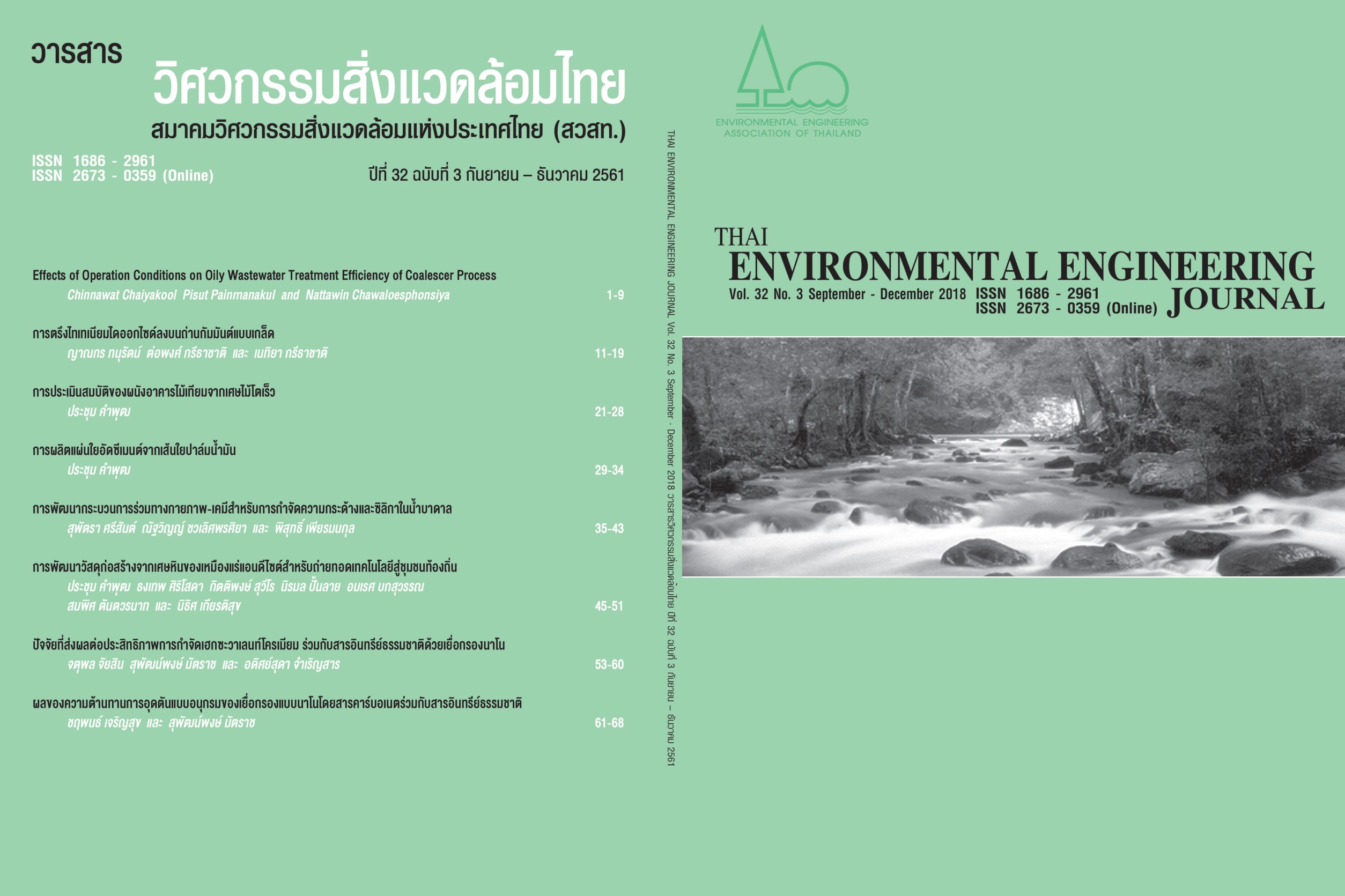Development of Combined Physico-Chemical Processes to Remove Hardness and Silica from Groundwater
Main Article Content
Abstract
The purpose of this research is to study the efficiency in removing hardness and silica in ground water using chemical treatment process - Nanofiltration of the makeup water system in cooling system. Because hardness and silica are primarily responsible for most scaling in pipe and cooling system. The primary process for this treatment is chemical treatment process called “coagulation/flocculation” to reduce membrane fouling of the Nanofiltration membrane. This is because membrane fouling led to membrane cleaning cost and lessens membrane lifespan. On this note, Quality of treated water will be considered efficient to reduce hardness and silica and the concentration cycle (CC). The concentration cycle will affect overall makeup water requirement in the water makeup process. The study the hybrid process revealed that the chemical process with calcium hydroxide 360 mg/L and PACl 1.2x10-4 mol Al/L and Nanofiltration process is operated at trans-membrane pressure 7 bar has the ability to remove overall hardness and most effective in removing Silica, having the ability to remove overall hardness and silica 96.5% and 67.0% respectively. This increase the number of reusability cycle of underground water from 0 to 4 cycle, meaning that the said treatment process can be used to treat water that was previously not usable to become usable alternative by the standard of the Japan Refrigeration and Air Conditioning Industry Association (JRA GL02-1994). The processed water was greatly improved and become usable as an alternative and can be cycled within the cooling system until the concentration amount of soluble cooling water reaches 4 times the amount. This helps reduce the requirement of makeup water for more than 56%. Furthermore, the chemical treatment process with calcium hydroxide and PACl helps reduce membrane fouling
Article Details
References
[2] F. Elazhar, R. EL Habbani, M. Elazhar, M. Hafsi, and A. Elmidaoui. 2013. Comparison of the performances of two commercial membranes in hardness removal from underground water using Nanofiltration membranes. Inter J Adv Chem. 1(2): 21-30.
[3] A. M. Al-Rehaili. 2003. Comparative chemical clarification for silica removal from RO groundwater feed. Desalination, 159. 21-31.
[4] Julia M. Frick, Liliana A. Féris, and Isabel C. Tessaro. 2014. Evaluation of pretreatments for a blowdown stream to feed a filtration system with discarded reverse osmosis membranes. Desalination. 341: 126-134.
[5] S. Salvador Cob, B. Hofs, C. Maffezzoni, J. Adamus, W. G. Siegers, E. R. Cornelissen, G. J. Witkamp. 2014. Silica removal to prevent silica scaling in reverse osmosis membranes. Desalination. 344: 137-143.
[6] C. Hsu-Hui, C. Shiao-Shing and Y. Shu-Ru. 2009. In-line coagulation/ultrafiltration for silica removal from brackish water as RO. Sep. Purif. Technol. 70, 112-117.
[7] N. Wei, Z. Zhang, D. Liu, Y. Wu, J. Wang, and Q. Wang. (2015). Coagulation behavior of polyaluminum chloride: Effects of pH and coagulant dosage. Chinese J. Chem. Eng. 23(6): 1041-1046.
[8] X. Wu. 2007. Distinct coagulation mechanism and model between alum and high Al13-PACl. Colloids Surfaces A. 305: 89-96.
[9] H. Tang, F. Xiao, and D. Wang. 2015. Speciation, stability, and coagulation mechanisms of hydroxyl aluminum clusters formed by PACl and alum: A critical review. Adv. Colloid Interfac. 226: 78-85.
[10] K. McCurdy, K. Carlson and D. Gregory. 2004. Floc morphology and cyclic shearing recovery: comparison of alum and polyaluminum chloride coagulants, Water Res. 38(2): 486-494.
[11] M. Seneviratne. 2006. A Practical Approach to Water Conservation for Comcercial and Industrial Facilities. United Kingdom: Butterworth-Heinemann.
[12] Metropolitan Waterworks Authority (MWA). 2001. Membrane Technology. Retrieved from https://www.mwa.co.th/download/ prd01/water_technology/other/awtp2.pdf [2016, September 4] (in Thai)


